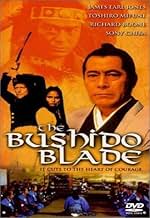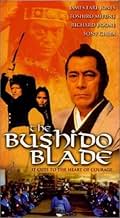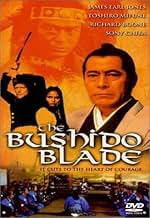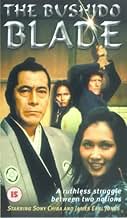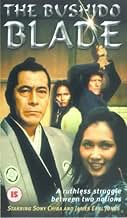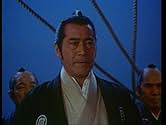अपनी भाषा में प्लॉट जोड़ेंA steel samurai blade that was to be given to the American ambassador by the Emperor of Japan is stolen. American sailors and Japanese samurai are sent to find it.A steel samurai blade that was to be given to the American ambassador by the Emperor of Japan is stolen. American sailors and Japanese samurai are sent to find it.A steel samurai blade that was to be given to the American ambassador by the Emperor of Japan is stolen. American sailors and Japanese samurai are sent to find it.
Mike Starr
- Bos'n Cave Johnson
- (as Michael Starr)
Timothy Patrick Murphy
- Midshipman Robin Burr
- (as Timothy Murphy)
Shin'ichi Chiba
- Prince Ido
- (as Sony Chiba)
Hitoshi Ômae
- Sumo
- (as Kin Omai)
फ़ीचर्ड समीक्षाएं
I read the premise on the back of the case and thought Bushido Blade would be a great movie. Granted, I knew movies about Japan made in years past could be somewhat contrived, but the description made it sound like a good adventure story in an interesting setting.
Unfortunately, this turned out to be less than that. While always entertaining, everything was a little gratuitous, a little forced, a little affected. The only particularly likable characters were Mifune's, Mako's and Chiba's, and the whole thing sort of just deflated as it went along.
Furthermore, I found myself laughing out loud at the particularly violent moments. Half of it was just at how intense they were, but a lot (if not most) of it was how unintentionally funny they were.
This leaves a lot to be desired. It's not bad by any means, but it has none of the magic that Mifune's other movies do.
Unfortunately, this turned out to be less than that. While always entertaining, everything was a little gratuitous, a little forced, a little affected. The only particularly likable characters were Mifune's, Mako's and Chiba's, and the whole thing sort of just deflated as it went along.
Furthermore, I found myself laughing out loud at the particularly violent moments. Half of it was just at how intense they were, but a lot (if not most) of it was how unintentionally funny they were.
This leaves a lot to be desired. It's not bad by any means, but it has none of the magic that Mifune's other movies do.
A co-production between Japan and U.S. company Rankin/Bass, THE BUSHIDO BLADE (1979) was an attempt to capitalize on a growing interest in Japanese history which culminated the following year in the successful 'Shogun' TV miniseries and the English-dubbed samurai film, SHOGUN ASSASSIN, a re-edit of two films from the Japanese 'Lone Wolf and Cub' series. THE BUSHIDO BLADE, however, was the wrong film at the right time, despite the fact that it was shot in Japan with a mixed cast of American actors and Japanese stars. A fanciful account of Americans in Japan in 1854, it was ultimately undone by its low budget, lack of excitement, and contrived script.
It's set at the time of Commodore Matthew C. Perry's second trip to Japan, in February 1854, and his attempt to get a signed treaty with the Shogun. The basic plot borrows more than a little from the 1972 samurai western, RED SUN, and has to do with the theft of a sword intended for the U.S. president by a Japanese faction opposed to the treaty. Acting without orders, three Americans--a marine captain and two sailors, one of whom speaks a little Japanese--go off in pursuit of the sword and have numerous encounters in the Japanese countryside before the big confrontation at the castle of Lord Yamato, the nobleman behind the theft of the blade.
Quite improbably, the Americans encounter more than a few Japanese--five in all--who happen to speak adequate English, one of whom, Enjiro (played by Japanese-American actor Mako), is based on an actual historical figure, the fisherman Manjiro, who had been shipwrecked and taken to America some years earlier, but who actually had no interaction with the Americans during Perry's second trip. The other Japanese characters are all rather unlikely candidates to be proficient English speakers in 1854 Japan, but they include some big name actors. Toshiro Mifune (YOJIMBO) plays the Shogun's Commander; Sonny Chiba (THE STREET FIGHTER) plays Prince Ido, a foe of Yamato; and Tetsuro Tamba (YOU ONLY LIVE TWICE) plays Lord Yamato. Laura Gemser seems to have wandered in from Italian exploitation films (the EMANUELLE series) to play a half-Japanese, half-'foreign' English-speaking female samurai who beds the American captain.
The only big names in the American cast are Richard Boone, a one-time TV star ('Have Gun, Will Travel') and character actor in his final film role (as Commodore Perry), and James Earl Jones, who has a cameo as a shipwrecked sailor who's been held by the Japanese for two years. The biggest American part, Captain Hawk, is played by Frank Converse, primarily a TV actor ('NYPD'), who is actually quite good at portraying America's particular 19th century brand of arrogance and self-importance. Timothy Murphy plays the young American lieutenant who becomes enamored of Japanese culture (and falls for a Japanese woman). Mike Starr, later a prominent character actor and comic player (GOODFELLAS, ED WOOD, DUMB AND DUMBER), appears in his first film as burly sailor Cave Johnson, who takes on a sumo wrestler in one of the film's comic sidebars.
Overall, the film is of interest to Japan buffs and samurai fans, but it's bound to be a disappointment to most others because of its hackneyed story, stilted direction and TV-movie style of shooting. The film got very little theatrical release in the U.S. and went straight to television in most areas.
It's set at the time of Commodore Matthew C. Perry's second trip to Japan, in February 1854, and his attempt to get a signed treaty with the Shogun. The basic plot borrows more than a little from the 1972 samurai western, RED SUN, and has to do with the theft of a sword intended for the U.S. president by a Japanese faction opposed to the treaty. Acting without orders, three Americans--a marine captain and two sailors, one of whom speaks a little Japanese--go off in pursuit of the sword and have numerous encounters in the Japanese countryside before the big confrontation at the castle of Lord Yamato, the nobleman behind the theft of the blade.
Quite improbably, the Americans encounter more than a few Japanese--five in all--who happen to speak adequate English, one of whom, Enjiro (played by Japanese-American actor Mako), is based on an actual historical figure, the fisherman Manjiro, who had been shipwrecked and taken to America some years earlier, but who actually had no interaction with the Americans during Perry's second trip. The other Japanese characters are all rather unlikely candidates to be proficient English speakers in 1854 Japan, but they include some big name actors. Toshiro Mifune (YOJIMBO) plays the Shogun's Commander; Sonny Chiba (THE STREET FIGHTER) plays Prince Ido, a foe of Yamato; and Tetsuro Tamba (YOU ONLY LIVE TWICE) plays Lord Yamato. Laura Gemser seems to have wandered in from Italian exploitation films (the EMANUELLE series) to play a half-Japanese, half-'foreign' English-speaking female samurai who beds the American captain.
The only big names in the American cast are Richard Boone, a one-time TV star ('Have Gun, Will Travel') and character actor in his final film role (as Commodore Perry), and James Earl Jones, who has a cameo as a shipwrecked sailor who's been held by the Japanese for two years. The biggest American part, Captain Hawk, is played by Frank Converse, primarily a TV actor ('NYPD'), who is actually quite good at portraying America's particular 19th century brand of arrogance and self-importance. Timothy Murphy plays the young American lieutenant who becomes enamored of Japanese culture (and falls for a Japanese woman). Mike Starr, later a prominent character actor and comic player (GOODFELLAS, ED WOOD, DUMB AND DUMBER), appears in his first film as burly sailor Cave Johnson, who takes on a sumo wrestler in one of the film's comic sidebars.
Overall, the film is of interest to Japan buffs and samurai fans, but it's bound to be a disappointment to most others because of its hackneyed story, stilted direction and TV-movie style of shooting. The film got very little theatrical release in the U.S. and went straight to television in most areas.
My review was written in January 1982 after a screening at Manhattan's Lyric theatre on 42nd St.:
Filmed in Japan using the facilities of Toho Studios in 1978, "The Bushido Blade" is an unexciting hybrid, using British financing, U. S. production and international casting. A forerunner of John Frankenheimer's new "The Challenge", "Blade" has already played cable-tv domestically before current booking under hasty title: "The Bloody Bushido Blade".
Period piece's plot (convoluted but unfolding in "Classics Illustrated" style) is concerned with Commodore Perry (Richard Boone) in Yokohama in 1854 opening diplomatic relations with Japan by signing a treaty with the Shogun. Hangup in the signing process is that the Shogun's gift to the U. S. president (title sword) has been stolen, and the Japanese, in particular the Shogun's commander (Toshiro Mifune), will lose face unless it is recovered.
Prince Edo (Sonny Chiba) sets out to retrieve the blade from rebel leader Lord Yamato (Tetsuro Tamba), with various U. S. sailors and their local helpers tagging along. By film's anticlimactic ending, marine Captain Hawk (Frank Converse) has been made an honorary samurai, and he and femme samurai Laura Gemser have zapped everybody in sight.
Though there is nudity and beheadings for the action trade, film plays more like a kiddie picture, with cardboard heroes, old-fashioned romance, and good versus evil. Acting ranges from the hammy (hand-waving and shouting by the late Richard Boone) to the animation of a plank of mahogany (B-film sex symbol Laura Gemser). Underutilization of name talent is irritating, with action star Sonny Chiba written out of most of the picture and James Earl Jones given an extraneous walk-on. Leading player Frank Converse is okay, but most fans will want him to make way for the more mythic types.
Low budget is obvious in lousy model shots to represent Perry's fleet and an absurd finale where Converse and chubby helper Michael Starr push over a flaming wood lighthouse to crush and burn Yamato's oddly unobservant samurai warriors. Many have tried to bring East and West together on film (e.g., John Boorman's "Hell in the Pacific" and Terence Young's "Red Sun") with usually phony results, the one constant factor being Mifunes' presence in the cast. He shows up once more in "Bushido Blade" (and yet again in "The Challenge"), but the material lets him and the viewer down.
Period piece's plot (convoluted but unfolding in "Classics Illustrated" style) is concerned with Commodore Perry (Richard Boone) in Yokohama in 1854 opening diplomatic relations with Japan by signing a treaty with the Shogun. Hangup in the signing process is that the Shogun's gift to the U. S. president (title sword) has been stolen, and the Japanese, in particular the Shogun's commander (Toshiro Mifune), will lose face unless it is recovered.
Prince Edo (Sonny Chiba) sets out to retrieve the blade from rebel leader Lord Yamato (Tetsuro Tamba), with various U. S. sailors and their local helpers tagging along. By film's anticlimactic ending, marine Captain Hawk (Frank Converse) has been made an honorary samurai, and he and femme samurai Laura Gemser have zapped everybody in sight.
Though there is nudity and beheadings for the action trade, film plays more like a kiddie picture, with cardboard heroes, old-fashioned romance, and good versus evil. Acting ranges from the hammy (hand-waving and shouting by the late Richard Boone) to the animation of a plank of mahogany (B-film sex symbol Laura Gemser). Underutilization of name talent is irritating, with action star Sonny Chiba written out of most of the picture and James Earl Jones given an extraneous walk-on. Leading player Frank Converse is okay, but most fans will want him to make way for the more mythic types.
Low budget is obvious in lousy model shots to represent Perry's fleet and an absurd finale where Converse and chubby helper Michael Starr push over a flaming wood lighthouse to crush and burn Yamato's oddly unobservant samurai warriors. Many have tried to bring East and West together on film (e.g., John Boorman's "Hell in the Pacific" and Terence Young's "Red Sun") with usually phony results, the one constant factor being Mifunes' presence in the cast. He shows up once more in "Bushido Blade" (and yet again in "The Challenge"), but the material lets him and the viewer down.
Bushido Blade is a film that kind of got lost with all the hoopla surrounding the Shogun TV mini-series. Commodore Perry's opening of Japan deserved a better treatment than what it got here.
No reflection on the cast, they certainly try hard enough. And the making of the film is a service of sorts because America is woefully ignorant about Japan other than knowing that they were our opponents in World War II.
Making his farewell appearance on the screen is Richard Boone as the crusty Commodore Matthew Calbraith Perry. From what little I know of Perry, Boone seems to have captured him very well. Perry was the younger brother of Oliver Hazard Perry who was the commander of the Great Lakes Navy that beat the British and kept them from invading us through Canada. Younger brother Cal (family and friends used Perry's middle name when addressing him)served in the United States Navy for over 30 years and the opening of Japan was the capstone of a great career.
Bushido Blade is a fictional sideline to the true events surrounding the treaty Perry signed with the Shogun. There was a faction in Japan who wanted to keep the country's isolationist policy going and were quite willing to do anything in that endeavor. They steal a ceremonial samurai sword that is to be presented to President Franklin Pierce by Perry. As this is a question of honor, the Japanese balk at signing the treaty at the last minute.
The Japanese insist on themselves recovering the sword, but Perry unofficially sends Marine Captain Frank Converse, Boatswain Mike Starr, and young Naval Midshipman Timothy Patrick Murphy on his own mission. The three get split up during an attack. The bulk of the film is the separate experiences of all three.
Frank Converse is a fine actor, but I couldn't quite believe him as an instant Samurai. When he has to battle the champion Samurai he gets a bit of help to say the least. Skill with a Samurai sword is not something one learns on the job or on the fly and by rights he should never have survived.
Young Timothy Patrick Murphy cuts a fine romantic figure as his odyssey includes a small romantic interlude with a young Japanese girl who is intrigued by this occidental who speaks her language. Murphy reminded me just a bit of Tyrone Power in Son of Fury. It was sad indeed that he died so young of AIDS, he had a great career ahead of him.
Such fine Japanese players as Toshiro Mifune, Tetsuro Tamba, and Mako fill their roles well. I very much enjoyed James Earl Jones who played a whaling harpooner who was a prisoner. Before the treaty was signed with Japan, sailors from the west who had the misfortune to be shipwrecked in Japan could expect never to see home again.
The Bushido Blade is an average film about a key incident in both American and Japanese history. It could have used a lot more of everything, direction, production values, editing. But the players did their best with it.
A good triple feature one day might be watching The Barbarian and the Geisha even with a woefully miscast John Wayne, The Bushido Blade, and the best film on 19th century Japan after the opening, The Last Samurai with Tom Cruise. It's a chance to see the Japanese as more than our enemies in World War II or having their city's destroyed by some prehistoric beast.
No reflection on the cast, they certainly try hard enough. And the making of the film is a service of sorts because America is woefully ignorant about Japan other than knowing that they were our opponents in World War II.
Making his farewell appearance on the screen is Richard Boone as the crusty Commodore Matthew Calbraith Perry. From what little I know of Perry, Boone seems to have captured him very well. Perry was the younger brother of Oliver Hazard Perry who was the commander of the Great Lakes Navy that beat the British and kept them from invading us through Canada. Younger brother Cal (family and friends used Perry's middle name when addressing him)served in the United States Navy for over 30 years and the opening of Japan was the capstone of a great career.
Bushido Blade is a fictional sideline to the true events surrounding the treaty Perry signed with the Shogun. There was a faction in Japan who wanted to keep the country's isolationist policy going and were quite willing to do anything in that endeavor. They steal a ceremonial samurai sword that is to be presented to President Franklin Pierce by Perry. As this is a question of honor, the Japanese balk at signing the treaty at the last minute.
The Japanese insist on themselves recovering the sword, but Perry unofficially sends Marine Captain Frank Converse, Boatswain Mike Starr, and young Naval Midshipman Timothy Patrick Murphy on his own mission. The three get split up during an attack. The bulk of the film is the separate experiences of all three.
Frank Converse is a fine actor, but I couldn't quite believe him as an instant Samurai. When he has to battle the champion Samurai he gets a bit of help to say the least. Skill with a Samurai sword is not something one learns on the job or on the fly and by rights he should never have survived.
Young Timothy Patrick Murphy cuts a fine romantic figure as his odyssey includes a small romantic interlude with a young Japanese girl who is intrigued by this occidental who speaks her language. Murphy reminded me just a bit of Tyrone Power in Son of Fury. It was sad indeed that he died so young of AIDS, he had a great career ahead of him.
Such fine Japanese players as Toshiro Mifune, Tetsuro Tamba, and Mako fill their roles well. I very much enjoyed James Earl Jones who played a whaling harpooner who was a prisoner. Before the treaty was signed with Japan, sailors from the west who had the misfortune to be shipwrecked in Japan could expect never to see home again.
The Bushido Blade is an average film about a key incident in both American and Japanese history. It could have used a lot more of everything, direction, production values, editing. But the players did their best with it.
A good triple feature one day might be watching The Barbarian and the Geisha even with a woefully miscast John Wayne, The Bushido Blade, and the best film on 19th century Japan after the opening, The Last Samurai with Tom Cruise. It's a chance to see the Japanese as more than our enemies in World War II or having their city's destroyed by some prehistoric beast.
It's always a little fascinating when a filmmaker undertakes a production at least partly outside their own country, and at least partly in another language. I would love the chance to read all about international co-productions like this, and learn how they came into being. What makes this instance particularly interesting, for good or maybe mostly for ill, is the ultimate form that it took, which is plainly evident very early on. Japanese filmmaker Kotani Tsugunobu may be directing (credited as "Tom Kotani"), and much of the picture may have been filmed in Japan with the cooperation of Toho. Why, much of the cast and crew is Japanese, including icons Mifune Toshiro and Sonny Chiba. Yet between the involvement of famed U. S. producers Rankin/Bass, and the screenplay of U. S. writer William Overgard, far more than not 'The bushido blade' absolutely feels from top to bottom like an exclusively Hollywood affair, and often in the worst of ways. This doesn't mean that it's not enjoyable - it is, to one degree or another - but the sincerity of it all is very much in question, and I'm also curious just how the contributors viewed their participation in retrospect.
Let's not beat around the bush: this does not treat Japan, its culture, or its people well. At best the feature offers a hopelessly simplified interpretation and depiction, and at worse the ignorant racism and jingoism of the nineteenth-century American characters is extended to the sensibilities with which the Japanese are portrayed. The Americans are roundly arrogant, with a conflated sense of self, virtue, and superiority; even when the script doesn't have the Americans specifically looking down on Japan as a backwards, quaint nation of "savages," the Americans are made out to be the definite heroes, and the Japanese to be the definite villains. And the thing is, despite the premise, there actually isn't a lot of room for nuance in this flick, for the characterizations are reduced and heavy-handed, if not purely archetypal or stereotypical - and the plot isn't far behind. One boyish, kindhearted sailor happens to have studied the language; his beefy uncle is much more physical and oafish; their designated leader will quizzically be dubbed an honorary samurai after being on Japanese soil for all of one day. One Japanese woman is soft and demure; one (played by Indonesian-Dutch actress Laura Gemser) is more dubious yet as she is The Fiery Warrior, The Warrior Poet, The Soft Woman, and The Romantic Interest all rolled into one.
I can forgive the very ahistorical story appended to a reimagined rendition of Commodore Perry arriving in Japan in the 1850s. I'm more concerned about the characters that fill discrete narrative roles, but without any hint of depth or nuance. I'm more concerned about how the scene writing flimsily tosses in sundry odds and ends that emphatically say "Japan!" for those viewers whose only experience with the Land of the Rising Sun is what they've seen or heard poorly represented on television: samurai, a violent code of honor, a long history of isolation, earthquakes. I'm certainly more concerned about how the plot at large seems rather loose, defined more by (a) some small set number of essential beats, and otherwise (b) general vibes, more than cogency, cohesiveness, or a mind for impactful drama or thrills. And I'm concerned by how even beyond conception and conjuration, the execution of this flick is wanting. Save for some nudity and greater levels of violence, this often comes across like the sort of highfalutin, "pip pip!" live-action adventure fare that Disney churned out in previous years. This sense comes from the writing, certainly, but also from the decided lack of polish in too many action sequences, as if professional stunt coordinators and fight choreographers weren't a thing. (At least "dueling master" Kuze Ryu shows that his involvement was not for nothing.) Sometimes it almost feels like Kotani was director in name only, and some unnamed American counterpart was actually in charge to see that all possible clichés and empty, tiresome tropes made their way in.
Sure, the filming locations are beautiful. The costume design is pretty sharp, and the production design and art direction. Some of the stunts and effects are better than others. It's reasonably well made. The movie is still entertaining to some extent, and I don't regret watching. But this needed so badly to be written and made more carefully, with more input from Kotani and Toho, and with less from Rankin/Bass. I don't know where precisely the responsibility lies for how this turned out, but I really have to wonder just how everyone felt about it when all was said and done as a title that frankly does a disservice to Japan and which in no meaningful way evinces anything except Hollywood with its all too common misrepresentations of This or That. Chiba is wasted here, and Mifune even more so; the same could surely be said for other stars. 'The bushido blade' is okay if you happen to come across it, but even if you're a huge fan of someone involved, there's no major reason to check it except as something light to pass the time on a quiet day. Maybe that's all it needed to be, but I expected something more solid and sure-footed.
Let's not beat around the bush: this does not treat Japan, its culture, or its people well. At best the feature offers a hopelessly simplified interpretation and depiction, and at worse the ignorant racism and jingoism of the nineteenth-century American characters is extended to the sensibilities with which the Japanese are portrayed. The Americans are roundly arrogant, with a conflated sense of self, virtue, and superiority; even when the script doesn't have the Americans specifically looking down on Japan as a backwards, quaint nation of "savages," the Americans are made out to be the definite heroes, and the Japanese to be the definite villains. And the thing is, despite the premise, there actually isn't a lot of room for nuance in this flick, for the characterizations are reduced and heavy-handed, if not purely archetypal or stereotypical - and the plot isn't far behind. One boyish, kindhearted sailor happens to have studied the language; his beefy uncle is much more physical and oafish; their designated leader will quizzically be dubbed an honorary samurai after being on Japanese soil for all of one day. One Japanese woman is soft and demure; one (played by Indonesian-Dutch actress Laura Gemser) is more dubious yet as she is The Fiery Warrior, The Warrior Poet, The Soft Woman, and The Romantic Interest all rolled into one.
I can forgive the very ahistorical story appended to a reimagined rendition of Commodore Perry arriving in Japan in the 1850s. I'm more concerned about the characters that fill discrete narrative roles, but without any hint of depth or nuance. I'm more concerned about how the scene writing flimsily tosses in sundry odds and ends that emphatically say "Japan!" for those viewers whose only experience with the Land of the Rising Sun is what they've seen or heard poorly represented on television: samurai, a violent code of honor, a long history of isolation, earthquakes. I'm certainly more concerned about how the plot at large seems rather loose, defined more by (a) some small set number of essential beats, and otherwise (b) general vibes, more than cogency, cohesiveness, or a mind for impactful drama or thrills. And I'm concerned by how even beyond conception and conjuration, the execution of this flick is wanting. Save for some nudity and greater levels of violence, this often comes across like the sort of highfalutin, "pip pip!" live-action adventure fare that Disney churned out in previous years. This sense comes from the writing, certainly, but also from the decided lack of polish in too many action sequences, as if professional stunt coordinators and fight choreographers weren't a thing. (At least "dueling master" Kuze Ryu shows that his involvement was not for nothing.) Sometimes it almost feels like Kotani was director in name only, and some unnamed American counterpart was actually in charge to see that all possible clichés and empty, tiresome tropes made their way in.
Sure, the filming locations are beautiful. The costume design is pretty sharp, and the production design and art direction. Some of the stunts and effects are better than others. It's reasonably well made. The movie is still entertaining to some extent, and I don't regret watching. But this needed so badly to be written and made more carefully, with more input from Kotani and Toho, and with less from Rankin/Bass. I don't know where precisely the responsibility lies for how this turned out, but I really have to wonder just how everyone felt about it when all was said and done as a title that frankly does a disservice to Japan and which in no meaningful way evinces anything except Hollywood with its all too common misrepresentations of This or That. Chiba is wasted here, and Mifune even more so; the same could surely be said for other stars. 'The bushido blade' is okay if you happen to come across it, but even if you're a huge fan of someone involved, there's no major reason to check it except as something light to pass the time on a quiet day. Maybe that's all it needed to be, but I expected something more solid and sure-footed.
क्या आपको पता है
- ट्रिवियाAlthough this film was derided as an attempt to copy the hit TV mini-series Shogun (1980), it was actually made in 1978, before Shogun (1980), though it wasn't released until after that series had aired.
- क्रेज़ी क्रेडिटThe producers gratefully acknowledge the cooperation of Toho Studios staff and personnel in the production of this picture.
- इसके अलावा अन्य वर्जनFirst shown in USA in a 92-minute version on cable television, prior to a theatrical release in the USA of the complete 104-minute version, this retitled "The Bloody Bushido Blade."
- कनेक्शनFeatured in Vintage Video: 0249 The Bushido Blade (1981) (2021)
टॉप पसंद
रेटिंग देने के लिए साइन-इन करें और वैयक्तिकृत सुझावों के लिए वॉचलिस्ट करें
- How long is The Bushido Blade?Alexa द्वारा संचालित
विवरण
इस पेज में योगदान दें
किसी बदलाव का सुझाव दें या अनुपलब्ध कॉन्टेंट जोड़ें



